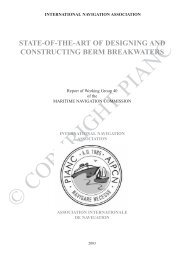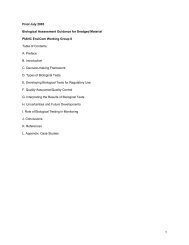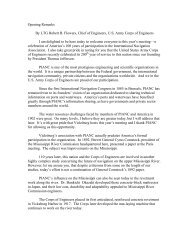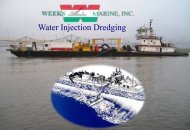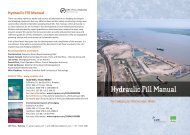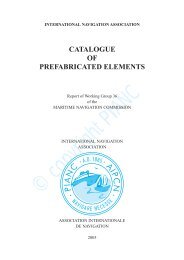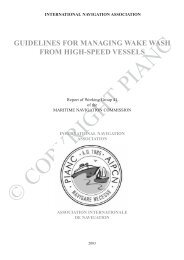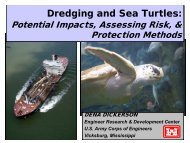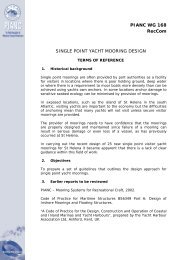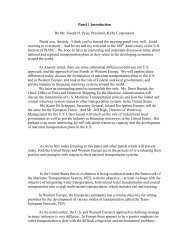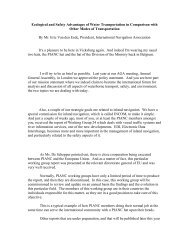Acoustics of Ship Collisions with Marine Animals
Acoustics of Ship Collisions with Marine Animals
Acoustics of Ship Collisions with Marine Animals
You also want an ePaper? Increase the reach of your titles
YUMPU automatically turns print PDFs into web optimized ePapers that Google loves.
<strong>Acoustics</strong> <strong>of</strong> <strong>Ship</strong> <strong>Collisions</strong> <strong>with</strong><br />
<strong>Marine</strong> <strong>Animals</strong><br />
Edmund R. Gerstein, Florida Atlantic University<br />
Laura A. Gerstein. Leviathan Legacy Inc.<br />
Joseph E. Blue, Leviathan Legacy Inc.<br />
Steven E. Forsythe, Naval Undersea Warfare Center<br />
USACE: WES<br />
NAVFAC: LEGACY<br />
FIND and FFWCC<br />
USFWS PRT 761873 and PRT 795477
<strong>Marine</strong> <strong>Animals</strong> for Discussion<br />
‣ Whales<br />
‣ Manatees<br />
‣ Both passive listeners dependent upon received<br />
acoustic signals<br />
‣ Both face the challenges detecting approaching<br />
vessels near the surface and many times in<br />
relatively shallow water
LETS TALK OF WHLAES FIRST<br />
While commonly identified and reported in coastal areas,<br />
collisions are not restricted to shipping lanes or shallow<br />
water. A common denominator is that they occur near the<br />
surface. Here prevailing acoustic conditions play a crucial<br />
role in the whales’ ability to detect and locate approaching<br />
ship noise.
Psychological Factors:<br />
SHIP AVOIDANCE<br />
‣ Sensory awareness:<br />
PARAMONT BEFORE ALL ELSE THERE MUST<br />
BE A STIMULUS TO BE PERCIEVED<br />
‣ Auditory Masking and critical ratios (critical bands)<br />
‣ Directional sensitivity, localization <strong>of</strong> ship noise<br />
‣ Auditory scene analysis, associative learning, biological<br />
significance<br />
‣ Habituation<br />
‣ States <strong>of</strong> arousal and attending
Most ship strikes occur <strong>with</strong> ships >80 meters
Factors in Determination <strong>of</strong> Sound<br />
Pressure Levels near the Surface<br />
ahead <strong>of</strong> a Vessel<br />
Spherical Spreading from Propellers<br />
Lloyd Mirror Effect<br />
Acoustic Shadowing and Diffraction
Factors to Consider for Acoustical<br />
Solutions<br />
‣ Spherical Propagation (prop to bow)<br />
‣ Acoustical Shadows<br />
‣ Lloyd Mirror Effect<br />
‣ Time-to<br />
to-Collision and Masking
Vessel Noise Sources<br />
A vessel’s propeller is the predominant noise<br />
source on it.<br />
In nearly all cases, the acoustic center <strong>of</strong> a vessel<br />
from which sound radiates can be taken as the<br />
center <strong>of</strong> the propellers. Far-field should be<br />
calculated from the acoustic center which for ships<br />
is most <strong>of</strong>ten the geometric center <strong>of</strong> the<br />
propellers.<br />
* Ross, Donald, Mechanics <strong>of</strong> Underwater Noise, Pergamon Press, New York<br />
(1976).
Propagation from stern<br />
‣ When considering propagation from large ships,<br />
the acoustic center for the ship going at a few<br />
knots is the propeller. Spherical spreading from<br />
stern applies.<br />
‣ What about hull borne sound<br />
• Much <strong>of</strong> hull vibration energy is evanescent.<br />
• High frequency energy is attenuated by the hull.<br />
• Low frequency energy is subject to Lloyd<br />
Mirror/Pressure Release Boundary Effect.<br />
• Resulting sound is masked by ambient noise.
Lloyd Mirror Effect Geometry<br />
This figure illustrates that the surface reflection can be viewed d as the<br />
combination <strong>of</strong> a direct arrival ray and a reflected ray that is 180° out<br />
<strong>of</strong> phase <strong>with</strong> the direct arrival or as an imaginary image source<br />
located the same distance above the surface as the real source depthd<br />
epth.
Loss from Lloyd Mirror Effect<br />
Hydrophone at 3-m 3 m depth<br />
Blue line – 100 meters<br />
Yellow line – 200 meters<br />
-5<br />
-10<br />
-15<br />
-20<br />
-25<br />
-30<br />
-35<br />
-40<br />
-45<br />
0 50 100 150 200 250 300 350 400<br />
FREQUENCY IN HZ
Spectral energy vs. frequency & time<br />
1.5meters and 7.5 meters
1.5 m and 7.5 m surface<br />
110<br />
100<br />
90<br />
ambient 7.5 meters<br />
ambient 1.5 m<br />
7.5m @ 1100 ft<br />
7.5m @ 550 ft<br />
7.5m @ 367 ft<br />
1.5 m @1100 ft<br />
1.5 m @ 550 ft<br />
1.5 m @ 366 ft<br />
80<br />
70<br />
60<br />
50<br />
1 10 100 1000<br />
Frequency (Hz)
Acoustic shadowing and diffraction
Diffraction illustration using sphere<br />
Let 2a = w =beam <strong>of</strong> a ship<br />
For w = 20 m, λ = 20π<br />
Frequency = 24 Hz
Diffraction illustration using sphere<br />
Let 2a = w =beam <strong>of</strong> a ship<br />
For w = 20 m, λ = 20π<br />
Frequency = 8 Hz
Diffraction illustration using sphere<br />
Let 2a = w =beam <strong>of</strong> a ship<br />
For w = 20 m, λ = 20π<br />
Frequency = 4.8 Hz
Pressure at 3 meters. Depth vs. horizontal angle for several frequencies. All<br />
distances are to scale. The ship is a blunted ellipsoid 50 meters long, 25 meters<br />
wide, and 12.5 meters deep (shown to scale). The prop is at half <strong>of</strong> the hull<br />
depth (6.25 meters) and 2 meters behind the stern end <strong>of</strong> the ship.
Disney Fantasy<br />
855’ length, 103’ beam, 26’ draft, twin props variable pitch<br />
12 KTS, surface recording depth 1.5 meters (distance 70’)
Acoustical shadowing<br />
Disney Fantasy 12 KTS, 40’ depth, 73 degrees F isothermal<br />
140<br />
130<br />
120<br />
110<br />
568 ft from bow 1.5 m<br />
0 ft from bow 1.5 m<br />
400 ft from stern 1.5 m<br />
0 ft from stern 1.5 m<br />
600 ft from stern 1.5 m<br />
ambient<br />
100<br />
90<br />
80<br />
70<br />
60<br />
0 5000 10000 15000 20000<br />
Frequency
Manatee Challenges from<br />
Barge and Tug Acoustic Shadows<br />
250’Barge 55’ Beam & 60’ Tug
Tilley Moran barge<br />
4 KTS, full load, recording depth 2 meters
The spreading loss from the propellers to the bow <strong>of</strong> the barge is ~ 40 dB. If one subtracts<br />
40 dB from the green or orange curves, one obtains levels near ambient a<br />
black curve) except at low frequencies where Lloyd Mirror increases the losses.<br />
Ambient<br />
75' away<br />
0 ft from edge<br />
75 ft over<br />
175 over<br />
back edge <strong>of</strong> barge<br />
at props<br />
4000 8000 12000 16000 20000<br />
Frequency (Hz)
Conclusions: Large <strong>Ship</strong>s<br />
‣ Spreading loss alone is sufficient to justify putting<br />
sound sources on the bow <strong>of</strong> large ships (>80-m m long).<br />
‣ The Lloyd Mirror Effect prevents very low frequency<br />
sounds that can diffract around ships from being heard<br />
near the surface<br />
‣ Acoustic shadowing on ships <strong>with</strong> props above keel<br />
level alone is sufficient to justify putting sound sources<br />
on large ship bows.<br />
‣ The confluence <strong>of</strong> the effects <strong>of</strong> spreading, shadowing<br />
and Lloyd Mirror make it very difficult for whales to<br />
hear large ships <strong>with</strong> props above keel level.
WHAT ABOUT MANATEES & BOATS
120<br />
100<br />
Manatee Audiogram<br />
Ambient Nosie<br />
80<br />
60<br />
40<br />
20<br />
100 1000 10000 100000<br />
Frequency Hz
120<br />
100<br />
Manatee Audiogram<br />
Ambient Nosie<br />
Human Diver<br />
80<br />
60<br />
40<br />
20<br />
100 1000 10000 100000<br />
Frequency Hz
Ambient sites composite<br />
100<br />
90<br />
Amplitude (Hz)<br />
80<br />
70<br />
60<br />
50<br />
msln 2<br />
msln 4<br />
irlk 2<br />
irlk 4<br />
bcir 2<br />
bcir 4<br />
mohc 2<br />
mohc 4<br />
hcrp 2<br />
hcrp 4<br />
tlbn 2<br />
tlbn 4<br />
syck 2<br />
syck 4<br />
nasa 2<br />
nasa 4<br />
40<br />
0 5000 10000 15000 20000<br />
Frequency (Hz)
27’ Regal 3.5 mph
27’ Regal 24 mph
27 ft Regal series<br />
Ambient<br />
Audiogram Reference<br />
Critical Ratios pt<br />
0 5000 10000 15000 20000<br />
Frequency (Hz)
27 ft Regal series<br />
Ambient<br />
Audiogram Reference<br />
Critical Ratios pt<br />
Critical Ratios noise<br />
27' Regal 3mph @ 8 s ~ 48 ft<br />
0 5000 10000 15000 20000<br />
Frequency (Hz)
27 ft Regal series<br />
Ambient<br />
Audiogram Reference<br />
Critical Ratios pt<br />
Critical Ratios noise<br />
27' Regal 3mph @ 8 s ~ 48 ft<br />
27' Regal 3mph @ 4 s ~ 24 ft<br />
0 5000 10000 15000 20000<br />
Frequency (Hz)
27 ft Regal series<br />
Ambient<br />
Audiogram Reference<br />
Critical Ratios pt<br />
Critical Ratios noise<br />
27' Regal 3mph @ 8 s ~ 48 ft<br />
27' Regal 3mph @ 4 s ~ 24 ft<br />
27' Regal 3mph @ 2 s ~ 12 ft<br />
0 5000 10000 15000 20000<br />
Frequency (Hz)
27 ft Regal series<br />
Ambient<br />
Audiogram Reference<br />
Critical Ratios pt<br />
Critical Ratios noise<br />
27' Regal 3mph @ 8 s ~ 48 ft<br />
27' Regal 3mph @ 4 s ~ 24 ft<br />
27' Regal 3mph @ 2 s ~ 12 ft<br />
27' Regal 3mph @ 0 s<br />
0 5000 10000 15000 20000<br />
Frequency (Hz)
27 ft Regal series<br />
Ambient<br />
Audiogram Reference<br />
Critical Ratios pt<br />
Critical Ratios noise<br />
27' Regal 24 mph @ 32 s ~ 1126<br />
0 5000 10000 15000 20000<br />
Frequency (Hz)
27 ft Regal series<br />
Ambient<br />
Audiogram Reference<br />
Critical Ratios pt<br />
Critical Ratios noise<br />
27' Regal 24 mph @ 32 s ~ 1126<br />
27' Regal 24mph @ 16s ~ 563<br />
0 5000 10000 15000 20000<br />
Frequency (Hz)
27 ft Regal series<br />
Ambient<br />
Audiogram Reference<br />
Critical Ratios pt<br />
Critical Ratios noise<br />
27' Regal 24 mph @ 32 s ~ 1126<br />
27' Regal 24mph @ 16s ~ 563<br />
27' Regal 24 mph @ 8 s ~282<br />
0 5000 10000 15000 20000<br />
Frequency (Hz)
27 ft Regal series<br />
Ambient<br />
Audiogram Reference<br />
Critical Ratios pt<br />
Critical Ratios noise<br />
27' Regal 24 mph @ 32 s ~ 1126<br />
27' Regal 24mph @ 16s ~ 563<br />
27' Regal 24 mph @ 8 s ~282<br />
27' Regal 24 mph @ 4 s ~ 141<br />
27' Regal 24mph @ 2 s ~ 71<br />
27' Regal 24mph @ 0<br />
0 5000 10000 15000 20000<br />
Frequency (Hz)
Comparison 3 mph vs 24 mph<br />
27 ft Regal series<br />
Ambient<br />
Audiogram Reference<br />
Critical Ratios pt<br />
Critical Ratios noise<br />
27' Regal 3mph @ 0 s<br />
27' Regal 24mph @ 0<br />
0 5000 10000 15000 20000<br />
Frequency (Hz)
Acoustic Consequences <strong>of</strong> Reducing<br />
Boat Speeds<br />
‣ Lessens cavitation noise and overall acoustic energy<br />
‣ Lowers the frequency content <strong>of</strong> the noise which<br />
reduces the audibility as well as directivity<br />
‣ Increases the likelihood <strong>of</strong> acoustic masking by the<br />
prevailing ambient levels and the noise <strong>of</strong> distant boats<br />
and ships while increasing transect times and<br />
opportunities for collisions.
Critical Time-To<br />
To-Collision<br />
Detecting the approach<br />
For whales and manatees to hear vessels, large<br />
or small, while underwater: The faster the vessel,<br />
the more time the animals have TO DETECT<br />
and possibly react and avoid the beam and draft.<br />
As demonstrated and predicted by Lighthill's<br />
Theory <strong>of</strong> Aerodynamic Sound, vessel noise<br />
intensity depends on ship speed.
Time-To<br />
To-Collision Theory<br />
Hearing by all passive listening mammals<br />
The continuity and momentum equations <strong>of</strong><br />
fluid mechanics written for regions that include<br />
mass and force source terms<br />
Dρ<br />
∂ρ<br />
+ ρ(<br />
∇ • v)<br />
= +<br />
Dt<br />
∂t<br />
∂(<br />
ρv<br />
∂x<br />
i<br />
)<br />
i<br />
=<br />
q<br />
DM<br />
Dt<br />
D(<br />
ρv<br />
∂v<br />
∫<br />
i<br />
= ( + ρvi<br />
V<br />
Dt ∂x<br />
j<br />
)<br />
j<br />
) dV
DM<br />
Dt<br />
Lighthill’s Theory <strong>of</strong> Aerodynamic<br />
D ρ<br />
Dt<br />
+<br />
D(<br />
ρv<br />
)<br />
ρ ( ∇<br />
<br />
• v )<br />
∂v<br />
j<br />
Sound<br />
=<br />
∂ ρ<br />
∂ t<br />
+<br />
∂(<br />
ρv<br />
)<br />
∂<br />
( ρ v<br />
∂ x<br />
j<br />
)<br />
i<br />
=<br />
Continuity equation in Lagrangian coordinants<br />
(co-moving derivatives)<br />
∂(<br />
ρv<br />
)<br />
∫<br />
i<br />
∫<br />
i<br />
i<br />
= V ( ~ ~ U + + δ<br />
δ + ρvi<br />
) dV = ( + vj<br />
+ ρvi<br />
V<br />
Dt ∂xi<br />
∂t<br />
∂v<br />
∂<br />
V j<br />
xj<br />
Rate <strong>of</strong> change <strong>of</strong> momentum<br />
I ~ U 5<br />
U is equal to the propeller tip velocity<br />
q<br />
∂v<br />
j<br />
) dV<br />
V ~ U + δ
Time-To<br />
To-Collision: Animal on hearing ship<br />
Theory – Results<br />
Relative time to collision for a vessel at prop tip speeds<br />
relative to the slow vessel. Solid line - spherical spreading<br />
Dotted - cylindrical
Time-To<br />
To-Collision Theory<br />
Discussion<br />
Using a relative speed <strong>of</strong> 2 for a ship, one sees<br />
from the curves that time-to<br />
to-collision for the<br />
faster ship is 8 to 35 times that <strong>of</strong> the slower<br />
one. The bad news is that the noise from the<br />
faster ship can mask the sounds <strong>of</strong> the slower<br />
ship out to 8 to 35 times the range <strong>of</strong> whale<br />
detection for the slower ship.
Closing Remarks On Whales<br />
NFMS proposed mitigations for reducing North Atlantic<br />
right whale collisions call for:<br />
Reducing vessel speed<br />
Rerouting shipping lanes<br />
Increased aerial survaillnce<br />
The blanket application <strong>of</strong> speed regulations can actually exacerbate the<br />
occurrence <strong>of</strong> ship strikes by reducing the audibility <strong>of</strong> approaching ships.<br />
The acoustic consequences must be mitigated.<br />
Adding directional noise sources using modulated ship noise projected from<br />
the bow could be employed to ensonify acoustic shadows and alert marine<br />
mammals directly ahead <strong>of</strong> ships.
An Acoustic Solution Designed for<br />
Manatees using Wavelet Analysis
Narrow band noise and manatee<br />
vocalizations
Manatee Warning Device<br />
The manatee warning device is designed to project a<br />
low intensity, highly directional narrow band <strong>of</strong><br />
sound in front <strong>of</strong> approaching boats. The selected<br />
signals exploit the manatees best hearing and<br />
localization abilities and are designed to enhance the<br />
manatees’ sensory awareness <strong>of</strong> approaching boats<br />
and ships.
Warning Device<br />
‣ Parametric projection technique enables a<br />
narrow beam <strong>with</strong> a small apertures, requires<br />
less power and little drag<br />
‣ The sounds are low intensity modulated sweeps<br />
that exploit the manatees most sensitive and<br />
directional hearing capabilities<br />
‣ The acoustic laws <strong>of</strong> directivity and absorption<br />
minimize the possibility <strong>of</strong> reinforcing and<br />
cumulative noise pollution concerns
Closing Remarks on Manatees<br />
‣ The growing number <strong>of</strong> surviving manatees <strong>with</strong> multiple scars patterns is consistent<br />
<strong>with</strong> increased slow speed zones in turbid waters.<br />
‣ While slow speed zones may reduce the chance <strong>of</strong> mortalities in turbid t<br />
waters it does<br />
not mitigate the occurrence collisions that can still mortally injure i<br />
individuals and<br />
reduce their fitness.<br />
‣ Blanket speed restrictions <strong>with</strong>out mitigating the associated acoustic consequences can<br />
exacerbate the risks <strong>of</strong> collisions through masking and increased transect times<br />
through populated areas.<br />
‣ Acoustic shadows ahead <strong>of</strong> commercial vessels and barges may be responsible r<br />
for<br />
many <strong>of</strong> these mortalities.<br />
‣ An acoustic array designed to fill in these shadows could help alert a<br />
manatees <strong>of</strong> an<br />
approaching ship or at the very least reduce the ambiguity <strong>of</strong> the e quiet zone ahead <strong>of</strong><br />
these vessels. Such a strategies may be helpful for whales that t face similar challenges<br />
from ships near the surface
After all boating and fishing was finally banned in Florida, a few f<br />
diehards went to Alaska where they could still fish.<br />
However, The Save the Orca Club by that time had learned how<br />
best to protect their marine mammals.



